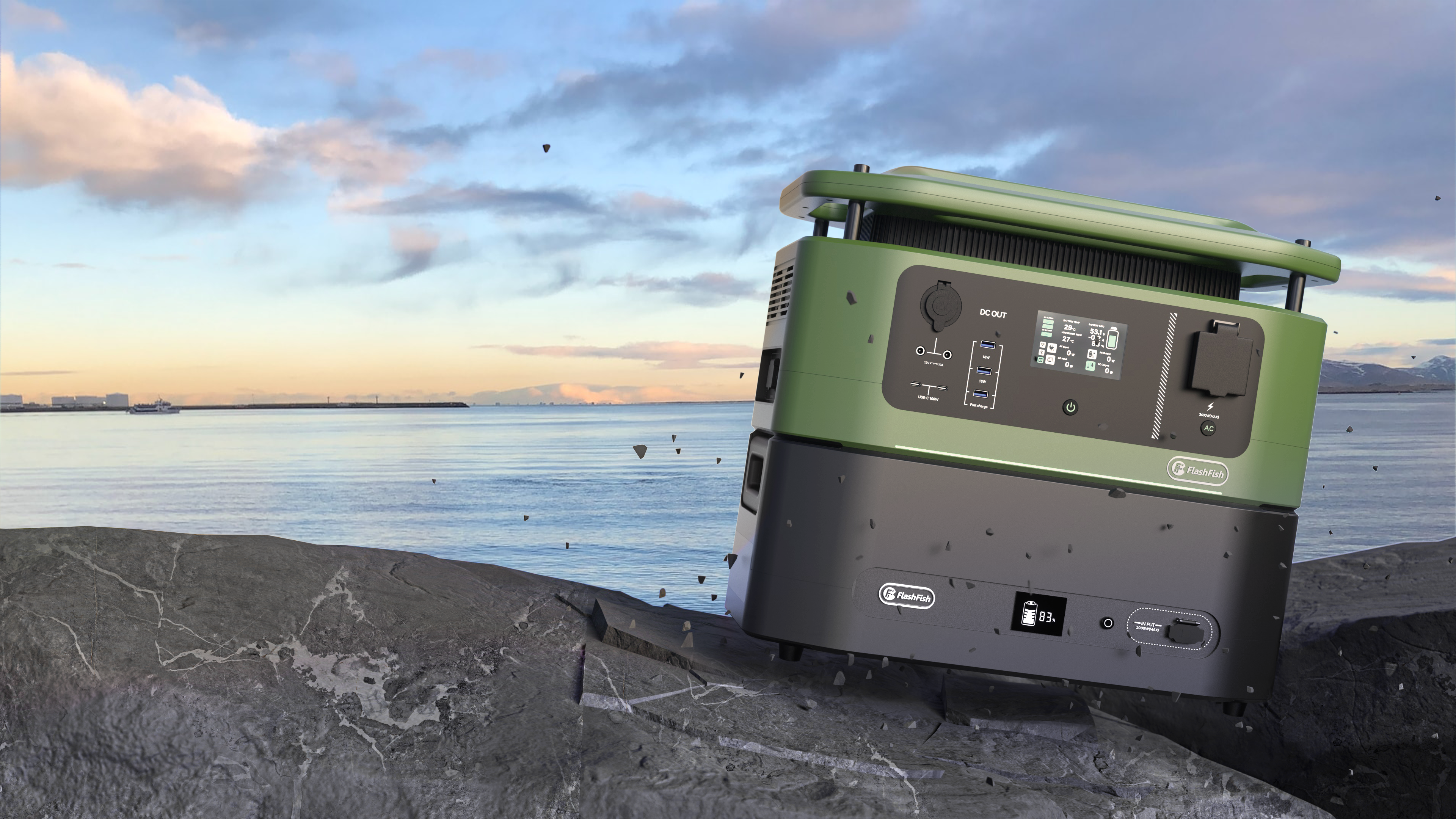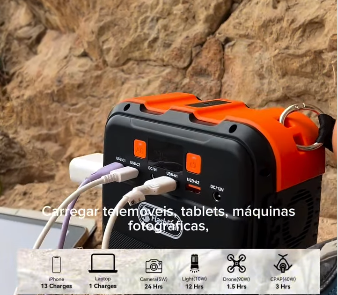NMC vs. LFP and the Impact of Environmental Factors 🌍🔋
At FlashFish, we are committed to providing high-quality energy storage solutions that meet your power needs. A crucial aspect of our products is the type of battery used, as it directly influences performance, longevity, and safety. In this blog post, we will explore the two primary battery chemistries used in our FlashFish energy storage products: Nickel Manganese Cobalt (NMC) and Lithium Iron Phosphate (LFP). Additionally, we will discuss how environmental factors can affect battery performance, capacity, and usage time.
1. Overview of Battery Types 🔍
Nickel Manganese Cobalt (NMC) Batteries

NMC batteries are a type of lithium-ion battery that combines nickel, manganese, and cobalt in their cathodes. This combination offers a balanced performance in terms of energy density, thermal stability, and lifespan.
Advantages of NMC Batteries:
- High Energy Density: NMC batteries provide a higher energy density, allowing for more power storage in a smaller and lighter package. This makes them ideal for applications where space and weight are critical. ⚡
- Versatile Performance: They perform well in various conditions, making them suitable for both high-power and high-energy applications.
Disadvantages of NMC Batteries:
- Cost: NMC batteries tend to be more expensive due to the use of cobalt and nickel, which can fluctuate in price. 💰
- Environmental Concerns: The mining and processing of cobalt raise ethical and environmental concerns.
Lithium Iron Phosphate (LFP) Batteries

LFP batteries use lithium iron phosphate as the cathode material and are known for their safety and longevity.
Advantages of LFP Batteries:
- Safety: LFP batteries are less prone to thermal runaway, making them one of the safest battery options available. They can withstand higher temperatures without risk of combustion. 🔥
- Long Lifespan: These batteries typically offer a longer cycle life, often exceeding 3,000 to 5,000 charge cycles, which translates to lower replacement costs over time. ⏳
- Cost-Effectiveness: LFP batteries are generally less expensive to produce, making them a more budget-friendly option for energy storage.
Disadvantages of LFP Batteries:
- Lower Energy Density: LFP batteries have a lower energy density compared to NMC batteries, which means they require more space for the same amount of energy storage. 📦
- Weight: They tend to be heavier than NMC batteries, which may be a consideration for portable applications.
2. Choosing the Right Battery for Your Needs 🤔
When selecting a battery for your FlashFish energy storage product, consider the following factors:
Application Requirements
- Energy Density: If you need a lightweight solution with high energy storage capacity (e.g., for portable power stations), NMC batteries may be the better choice.
- Safety and Longevity: If safety and long lifespan are your top priorities (e.g., for stationary applications), LFP batteries are an excellent option.
Budget Considerations
- Initial Cost vs. Long-Term Value: While NMC batteries may have a higher upfront cost, their performance may justify the investment for certain applications. Conversely, LFP batteries offer a more budget-friendly option with lower replacement costs over time.
Environmental Impact
- Sustainability: If environmental concerns are important to you, LFP batteries may be the preferable choice due to their lower environmental impact and ethical sourcing. 🌱
3. The Impact of Environmental Factors on Battery Performance 🌡️
Environmental conditions can significantly affect the performance and lifespan of batteries. Here are some key factors to consider:
Temperature
- High Temperatures: Elevated temperatures can lead to increased self-discharge rates and may accelerate battery degradation. NMC batteries, while stable, can still be affected by extreme heat, potentially reducing their lifespan.
- Low Temperatures: Cold temperatures can reduce the chemical reactions within the battery, leading to decreased capacity and performance. Both NMC and LFP batteries may experience reduced efficiency in cold conditions, but LFP batteries tend to perform better in extreme temperatures. ❄️
Humidity
- High Humidity: Excess moisture can lead to corrosion of battery terminals and connections, impacting performance. Proper sealing and protection are essential for both battery types to ensure longevity in humid environments.
- Low Humidity: While low humidity is generally less of a concern, it can still affect the overall performance of the battery if it leads to extreme temperature fluctuations.
Altitude
- High Altitude: At higher altitudes, the lower atmospheric pressure can affect battery performance, particularly in terms of cooling and heat dissipation. This is more relevant for NMC batteries, which may require additional thermal management in such conditions.
Conclusion 🎉
Choosing the right battery for your FlashFish energy storage products is crucial for maximizing performance, safety, and longevity. By understanding the differences between NMC and LFP batteries, as well as the impact of environmental factors on battery performance, you can make an informed decision that aligns with your specific needs and values.
At FlashFish, we are dedicated to providing you with the best energy storage solutions, ensuring you have the power you need when you need it. For more information on our products and battery options, please visit our website or contact our customer support team. Stay powered, stay prepared, and choose FlashFish for your energy storage needs! ⚡🔋
Environmental Factors 🌍🔋
At FlashFish, we are committed to providing high-quality energy storage solutions that meet your power needs. A crucial aspect of our products is the type of battery used, as it directly influences performance, longevity, and safety. In this blog post, we will explore the two primary battery chemistries used in our FlashFish energy storage products: Nickel Manganese Cobalt (NMC) and Lithium Iron Phosphate (LFP). Additionally, we will discuss how environmental factors can affect battery performance, capacity, and usage time.
1. Overview of Battery Types 🔍
Nickel Manganese Cobalt (NMC) Batteries
NMC batteries are a type of lithium-ion battery that combines nickel, manganese, and cobalt in their cathodes. This combination offers a balanced performance in terms of energy density, thermal stability, and lifespan.
Advantages of NMC Batteries:
- High Energy Density: NMC batteries provide a higher energy density, allowing for more power storage in a smaller and lighter package. This makes them ideal for applications where space and weight are critical. ⚡
- Versatile Performance: They perform well in various conditions, making them suitable for both high-power and high-energy applications.
Disadvantages of NMC Batteries:
- Cost: NMC batteries tend to be more expensive due to the use of cobalt and nickel, which can fluctuate in price. 💰
- Environmental Concerns: The mining and processing of cobalt raise ethical and environmental concerns.
Lithium Iron Phosphate (LFP) Batteries
LFP batteries use lithium iron phosphate as the cathode material and are known for their safety and longevity.
Advantages of LFP Batteries:
- Safety: LFP batteries are less prone to thermal runaway, making them one of the safest battery options available. They can withstand higher temperatures without risk of combustion. 🔥
- Long Lifespan: These batteries typically offer a longer cycle life, often exceeding 3,000 to 5,000 charge cycles, which translates to lower replacement costs over time. ⏳
- Cost-Effectiveness: LFP batteries are generally less expensive to produce, making them a more budget-friendly option for energy storage.
Disadvantages of LFP Batteries:
- Lower Energy Density: LFP batteries have a lower energy density compared to NMC batteries, which means they require more space for the same amount of energy storage. 📦
- Weight: They tend to be heavier than NMC batteries, which may be a consideration for portable applications.
2. Choosing the Right Battery for Your Needs 🤔
When selecting a battery for your FlashFish energy storage product, consider the following factors:
Application Requirements
- Energy Density: If you need a lightweight solution with high energy storage capacity (e.g., for portable power stations), NMC batteries may be the better choice.
- Safety and Longevity: If safety and long lifespan are your top priorities (e.g., for stationary applications), LFP batteries are an excellent option.
Budget Considerations
- Initial Cost vs. Long-Term Value: While NMC batteries may have a higher upfront cost, their performance may justify the investment for certain applications. Conversely, LFP batteries offer a more budget-friendly option with lower replacement costs over time.
Environmental Impact
- Sustainability: If environmental concerns are important to you, LFP batteries may be the preferable choice due to their lower environmental impact and ethical sourcing. 🌱
3. The Impact of Environmental Factors on Battery Performance 🌡️
Environmental conditions can significantly affect the performance and lifespan of batteries. Here are some key factors to consider:
Temperature
- High Temperatures: Elevated temperatures can lead to increased self-discharge rates and may accelerate battery degradation. NMC batteries, while stable, can still be affected by extreme heat, potentially reducing their lifespan.
- Low Temperatures: Cold temperatures can reduce the chemical reactions within the battery, leading to decreased capacity and performance. Both NMC and LFP batteries may experience reduced efficiency in cold conditions, but LFP batteries tend to perform better in extreme temperatures. ❄️
Humidity
- High Humidity: Excess moisture can lead to corrosion of battery terminals and connections, impacting performance. Proper sealing and protection are essential for both battery types to ensure longevity in humid environments.
- Low Humidity: While low humidity is generally less of a concern, it can still affect the overall performance of the battery if it leads to extreme temperature fluctuations.
Altitude
- High Altitude: At higher altitudes, the lower atmospheric pressure can affect battery performance, particularly in terms of cooling and heat dissipation. This is more relevant for NMC batteries, which may require additional thermal management in such conditions.
Conclusion 🎉
Choosing the right battery for your FlashFish energy storage products is crucial for maximizing performance, safety, and longevity. By understanding the differences between NMC and LFP batteries, as well as the impact of environmental factors on battery performance, you can make an informed decision that aligns with your specific needs and values.
At FlashFish, we are dedicated to providing you with the best energy storage solutions, ensuring you have the power you need when you need it. For more information on our products and battery options, please visit our website or contact our customer support team. Stay powered, stay prepared, and choose FlashFish for your energy storage needs! ⚡🔋






Yorum yazın
Bu site hCaptcha ile korunuyor. Ayrıca bu site için hCaptcha Gizlilik Politikası ve Hizmet Şartları geçerlidir.